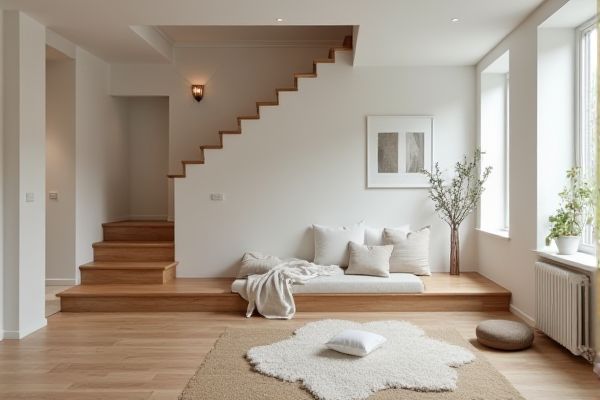
Open understairs designs create a spacious, airy feel by leaving the area beneath the stairs exposed, enhancing light flow and visual continuity in your home. Discover the advantages and drawbacks of both open and closed understairs options to determine which best suits your space and lifestyle.
Table of Comparison
| Feature | Open Understairs | Closed Understairs |
|---|---|---|
| Design | Exposed, minimalistic, modern look | Enclosed, traditional, defined space |
| Storage | Limited to shelves or open racks | Ample storage with cabinets, closets |
| Space Utilization | Less efficient, airy feel | Maximized, organized storage |
| Accessibility | Easy access | May require doors or panels |
| Maintenance | Easy to clean, dust collects easily | Requires regular cleaning, concealed dust |
| Cost | Generally lower cost | Higher cost due to materials and installation |
Introduction to Understairs Spaces
Open understairs spaces maximize usable area by offering accessible and visually connected storage or display options, enhancing room openness and light flow. Closed understairs compartments prioritize privacy and concealment, providing discreet storage that keeps clutter out of sight and maintains a streamlined appearance. Choosing between open and closed understairs designs depends on balancing aesthetic preferences with functional storage needs in interior layouts.
Open Understairs: Definition and Key Features
Open understairs refer to a design where the space beneath a staircase is left exposed or partially open, often incorporating shelves, storage cubbies, or seating areas without full enclosure. Key features include enhanced accessibility, improved airflow, and the ability to visually expand your interior space by reducing heavy structural elements. This style is ideal for maximizing utility and aesthetic appeal in smaller homes or areas needing versatile storage solutions.
Closed Understairs: Definition and Key Features
Closed understairs refer to a storage or functional space beneath a staircase that is fully enclosed by walls or panels, creating a distinct and separate area. Key features include concealed access points such as doors or drawers, maximizing privacy and organization while maintaining a clutter-free appearance. This design enhances structural safety and can be customized with shelving, cupboards, or utility installations tailored to specific household needs.
Design Aesthetics: Open vs Closed Understairs
Open understairs design emphasizes spaciousness and visual flow, enhancing your home's modern aesthetic with light and airy feel. Closed understairs offer a more traditional, defined look, providing an opportunity to incorporate storage or decorative elements that complement your interior style. Choosing between open and closed understairs depends on your preference for openness versus functionality in your home's design.
Space Utilization: Maximizing Storage Solutions
Open understairs designs optimize space utilization by creating accessible storage that visually expands your area, allowing for customized shelving or cubbies ideal for frequently used items. Closed understairs offer concealed storage, maximizing space efficiency by hiding clutter and providing dedicated compartments for varied household goods. Your choice between open or closed understairs significantly impacts the organization potential and overall aesthetic of your living space.
Accessibility and Convenience
Open understairs design offers superior accessibility and convenience by providing easy access to stored items without the need to open doors or panels, making it ideal for frequently used spaces. Closed understairs compartments protect belongings from dust and enhance the overall aesthetic but may require more effort to reach stored items due to hinged doors or sliding panels. Choosing between open and closed understairs depends on how often you need access and whether prioritize visibility or tidiness in your storage solution.
Maintenance: Cleaning and Upkeep Considerations
Open understairs designs facilitate easier cleaning and maintenance due to their accessible surfaces and reduced accumulation of dust and debris in corners. Closed understairs, featuring enclosed storage or walls, often require more frequent attention to prevent dirt buildup in hidden areas and may need specialized cleaning tools to reach tight spots. Proper upkeep of closed understairs can prevent mold and pest issues caused by moisture and poor ventilation.
Cost Comparison: Open vs Closed Understairs
Open understairs generally cost less than closed understairs due to simpler construction and reduced material requirements. Closed understairs involve additional framing, drywall, and finishing, increasing labor and material expenses. Your budget may benefit from choosing an open understairs design if you seek a cost-effective solution without sacrificing functionality.
Safety and Privacy Factors
Closed understairs enclosures enhance safety by preventing accidental falls and restricting access to electrical or storage areas, reducing injury risk in your home. Open understairs designs prioritize visibility and airflow but may compromise privacy and safety, especially in households with children or pets. Choosing a closed option provides a secure, private space that minimizes hazards while maintaining an organized appearance.
Choosing the Right Option for Your Home
Open understairs designs maximize space and natural light, creating an airy and modern feel ideal for smaller homes or those seeking a contemporary aesthetic. Closed understairs provide enhanced privacy and storage possibilities, making them perfect for homes requiring organized, hidden areas such as closets or utility rooms. Your choice should balance functionality, style, and the specific needs of your living space to optimize both comfort and utility.
 homyna.com
homyna.com